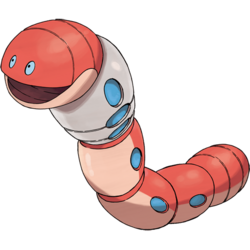From Bulbapedia, the community-driven Pokémon encyclopedia.

|
The subject of this article is a Pokémon which has recently been announced.
This article's contents will change as more information becomes available, perhaps abruptly. Please be cautious when adding information to this article, as rumors and speculation can often be confused with facts. Avoid any information on this subject which is not confirmed by reliable sources.
|
Orthworm (Japanese: ミミズズ Mimizuzu) is a Steel-type Pokémon introduced in Generation IX.
It is not known to evolve into or from any other Pokémon.
Biology
Orthworm is a long, worm-like Pokémon with a six-segmented metal body. Its body is red on top and light orange on the bottom, except for its second segment, which is steel-colored. The first segment is its head, which contains its small, pale blue eyes and a large, toothless mouth. There are pairs of cyan ovals lining either side of its body from its third to fifth segments, while its second segment has three of such pairs. Tendrils can extend from the ovals on its second segment, which resemble simple fists. When threatened, Orthworm uses these tendrils to punch its opponents. Orthworm lives in dry deserts, and eats iron from the soil to maintain its body. It is sometimes seen buried in the ground, with only its head visible.
Orthworm is the only known Pokémon with the Ability of Earth Eater.
A giant Orthworm, known as the Lurking Steel Titan, is one of the Titan Pokémon found in the Paldea region.
In the anime
Major appearances
Minor appearances
In the manga
In the TCG
- Main article: Orthworm (TCG)
Game data
Pokédex entries
| This Pokémon was unavailable prior to Generation IX.
|
| Generation IX
|
|
|
Paldea
#296
|
| Scarlet
|
When attacked, this Pokémon will wield the tendrils on its body like fists and pelt the opponent with a storm of punches.
|
| Violet
|
This Pokémon lives in arid deserts. It maintains its metal body by consuming iron from the soil.
|
|
|
Game locations
| This Pokémon was unavailable prior to Generation IX.
|
|
|
In side games
Held items
Stats
Base stats
| Stat
|
Range
|
| At Lv. 50
|
At Lv. 100
|
70
|
|
130 - 177
|
250 - 344
|
85
|
|
81 - 150
|
157 - 295
|
145
|
|
135 - 216
|
265 - 427
|
60
|
|
58 - 123
|
112 - 240
|
55
|
|
54 - 117
|
103 - 229
|
65
|
|
63 - 128
|
121 - 251
|
Total: 480
|
Other Pokémon with this total
|
- Minimum stats are calculated with 0 EVs, IVs of 0, and (if applicable) a hindering nature.
- Maximum stats are calculated with 252 EVs, IVs of 31, and (if applicable) a helpful nature.
|
Type effectiveness
| Under normal battle conditions in Generation IX, this Pokémon is:
|
|
|
|
|
|
|
|
|
|
|
|
|
Learnset
|
|
|
|
- Bold indicates a move that gets STAB when used by Orthworm
- Italic indicates a move that gets STAB only when used by an Evolution of Orthworm
|
|
|
|
|
- Bold indicates a move that gets STAB when used by Orthworm
- Italic indicates a move that gets STAB only when used by an Evolution or an alternate form of Orthworm
|
|
|
|
|
- Moves marked with an asterisk (*) must be chain bred onto Orthworm
- Bold indicates a move that gets STAB when used by Orthworm
- Italic indicates a move that gets STAB only when used by an Evolution of Orthworm
|
Side game data
Evolution
Sprites
Trivia
Origin
Orthworm appears to be based on an earthworm, and also shares similarities to a subway train. Orthworm's tendrils may be derived from the pronounced parapodia of polychaetes, relatives of earthworms. The Titan Orthworm may also possibly take some inspiration from giant sandworms, a common archetype of monster popularized through works like Dune and Beetlejuice.
Name origin
Orthworm may be a combination of ore and earthworm.
Mimizuzu may be a combination of 蚯蚓 mimizu (earthworm) and 埋める uzumeru (to bury).
In other languages
| Language
|
Title
|
Meaning
|
 Japanese Japanese
|
ミミズズ Mimizuzu
|
From 蚯蚓 mimizu and 埋める uzumeru
|
 French French
|
Ferdeter
|
From fer and ver de terre
|
 Spanish Spanish
|
Orthworm
|
Same as English name
|
 German German
|
Schlurm
|
From schleppen and Wurm
|
 Italian Italian
|
Orthworm
|
Same as English name
|
 Korean Korean
|
꿈트렁 Kkumteureong
|
From 꿈틀꿈틀 kkumteul-kkumteul and 지렁이 jireong-i
|
 Mandarin Chinese Mandarin Chinese
|
拖拖蚓 Tuōtuōyǐn
|
From 拖 tuō and 蚯蚓 qiūyǐn
|
 Cantonese Chinese Cantonese Chinese
|
拖拖蚓 Tōtōyáhn
|
From 拖 tō and 蚯蚓 yāuyáhn
|
|
|
|
|
|
|
|
Related articles
External links

|
This Pokémon article is part of Project Pokédex, a Bulbapedia project that aims to write comprehensive articles on each Pokémon species, as well as Pokémon groups and forms.
|



